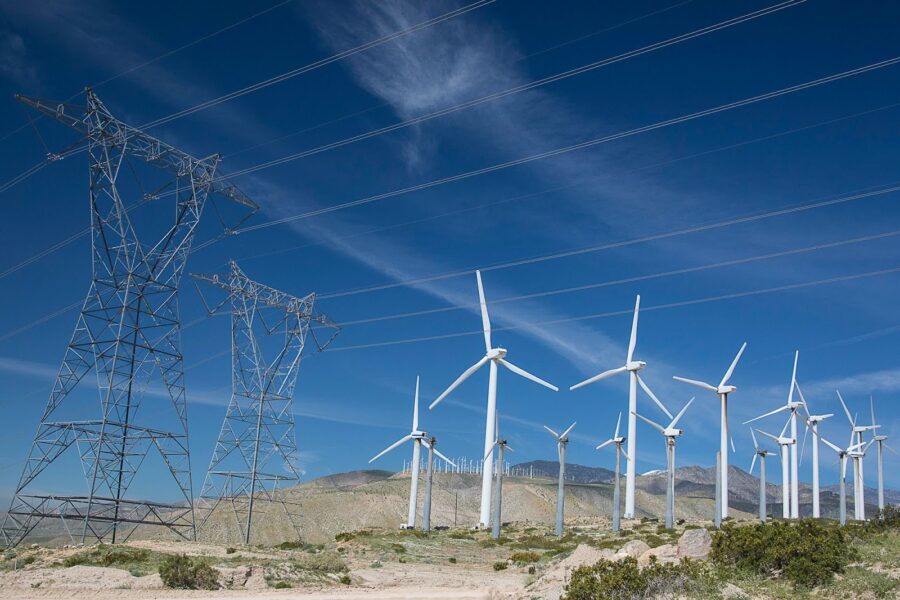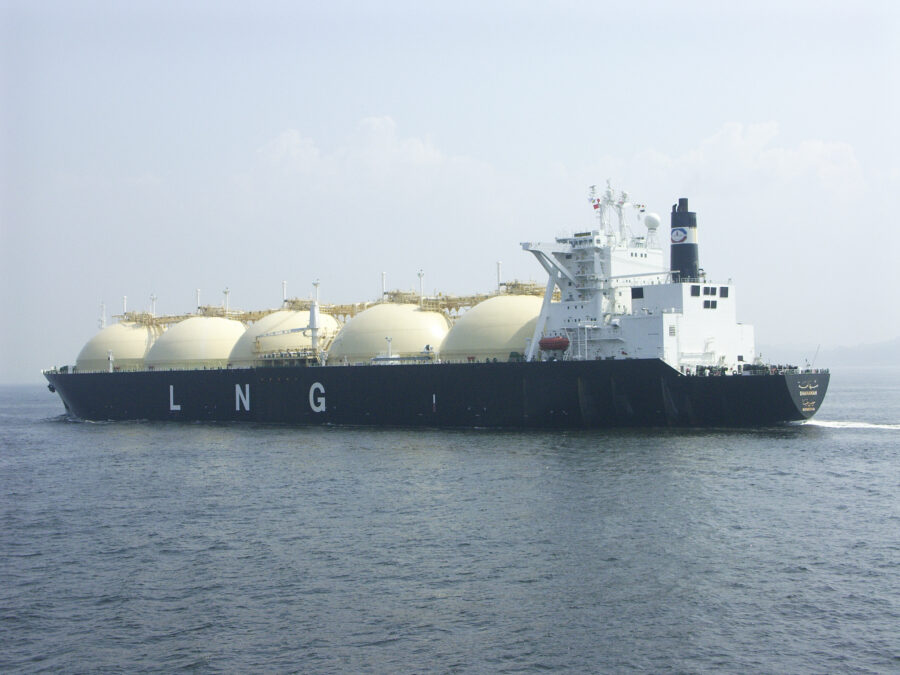Sens. Joe Manchin and John Barrasso offer a devil’s bargain: new power lines for clean energy transmission at the cost of more fossil fuels.
|
Listen To This Story
|
To advance his climate agenda, President Joe Biden has prioritized one scheme above all others: infrastructure subsidies. The massive spending packages his administration pushed through Congress over the past four years — the bipartisan infrastructure law and the Inflation Reduction Act — provided an infusion of dollars for green energy developers to erect solar farms, geothermal plants, and new transmission lines to carry clean electricity into American homes.
But before companies can break ground on these projects, they must obtain approval from local communities and federal regulators, and that’s where the projects often hit a snag. The permitting process for new energy projects is notoriously long and complex, and sometimes funding and investor interest dry up before it’s ever complete.
That’s why, many environmental advocates agree, there’s a real climate case for reforming the permitting process — making it easier to get approval for new energy projects more quickly. For a permitting reform bill to get through Congress, however, it would likely have to also make it easier for states to approve new permits from the fossil fuel industry.
Sen. Joe Manchin, an independent from West Virginia, has led efforts to reform the permitting process on the Senate’s Energy and Natural Resources Committee for the past four years. After a failed attempt at passing a permitting reform package in 2022, the senator got to work crafting a new piece of legislation that he hoped would garner more bipartisan support. He finally proposed the results of that effort last week alongside Sen. John Barrasso, a Republican from Wyoming. The new bill contains concessions for a range of policy makers, from green energy advocates to oil and gas enthusiasts and mining proponents. It passed in Manchin’s Senate committee on Wednesday by a bipartisan vote of 15-4.
Manchin, who will not seek reelection after this term, has a long-standing investment in the greenlighting of fossil fuel projects, including the controversial Mountain Valley Pipeline in West Virginia and gas export terminals on the Gulf Coast, so it’s no surprise that environmental advocacy groups are not so enthusiastic about the new bill. The Natural Resources Defense Council, or NRDC, called it “a fossil fuel wolf in clean energy clothing.” Advocates from Earthjustice also published a statement urging Congress to reject the proposal and instead pass legislation that will “help us reach our clean energy goals while protecting communities.” Their concerns come down to the bill’s concessions for the fossil fuel companies, which would be able to get liquefied natural gas export terminals approved more easily and to increase oil and gas extraction on public lands. The US is already at record levels of oil and gas production, and the provisions in Manchin and Barrasso’s bill that deal with leasing on public lands would essentially make it difficult for that situation to change.
All energy-related infrastructure projects carry risks for communities of the country’s oil and gas heartlands, which are disproportionately low-income and non-white. And like any piece of energy legislation that seeks to appease many parties, the central question with the Manchin-Barrasso bill is whether the climate benefits outweigh the costs — both in terms of carbon emissions and health risk to communities on the front lines. In this bill, those climate benefits take the form of streamlining the process by which new transmission lines — the giant power lines that form the backbone of the energy grid — are approved, which would help enable the massive buildout of these power lines that is required for the transition to carbon-free energy. But those benefits must be weighed against the costs of approving new fossil fuel infrastructure.
Brett Hartl, the government affairs director of the Center for Biological Diversity, said environmental advocates are generally not opposed to some transmission permitting reforms, because of the urgent need to transmit renewable energy, but their willingness to compromise is being held hostage to a bargain many find unacceptable. “What Manchin constantly does is say that the price is more fossil fuels,” he said.
Why Streamline Transmission Buildout?
A quarter of the country’s carbon emissions come from the electricity sector, making it a common battleground for policymakers trying to wean the economy off fossil fuels. Spurred by billions in federal subsidies and tax breaks intended to “de-risk” investment in clean energy, renewable energy has become remarkably cheap to build, and the US now generates eight times the amount of solar energy that it did a decade ago. But in order to maximize the carbon savings from wind and solar energy — and in order to enable the even greater renewable buildout that would be necessary to achieve America’s net-zero emissions target — there’s another infrastructural hurdle to overcome: the deeply inadequate network of transmission lines.
America’s fragmented patchwork of power grids was largely built in the mid-20th century, and the placement of transmission lines reflects that era’s power generation methods. Whereas coal and nuclear plants are generally located near bodies of water, which they rely upon for cooling, and as close to population centers as is feasible, solar farms need large tracts of cheap, sunny, flat land, and wind turbines need similarly remote locales — requiring new transmission lines to connect them to the grid. What’s more, simply hooking up a renewable power plant to a grid isn’t enough. Because wind and solar are intermittent — reliant upon variable weather patterns — maximizing their full benefits requires an increased buildout of interregional transmission, or the power lines that connect grids to one another, so that, for instance, if it’s windy in Texas but overcast in Georgia, Atlanta’s power consumers can still access carbon-free electricity.
Last year, a Department of Energy study estimated that, in order to meet the Biden administration’s goal of net-zero power sector emissions by 2035, the amount of regional transmission needs to double, and the amount of interregional transmission needs to increase fivefold.

Photo credit: Bureau of Land Management California / Flickr (PDM 1.0 DEED)
In its current state, “the transmission system can’t accommodate the type of renewable growth that Congress was trying to promote” in the Inflation Reduction Act, said Devin Hartman, director of energy and environmental policy at the think tank R Street Institute. Researchers at Princeton University’s ZERO Lab estimated in 2022 that more than 80 percent of the potential emissions cuts of the IRA depend on doubling the current rate of transmission buildout nationally.
But building those wires is a cumbersome process. It takes nearly a decade on average to build an interregional transmission line, with holdups at virtually every step of the process. And building interregional transmission often works against the profit interests of the most influential — and moneyed — parties in the power sector: the utilities who deliver electricity within regional power grids, like Duke Energy or the Southern Company. Building transmission exposes them to competition from other power companies who can undercut their prices.
Aidan Mackenzie, a researcher at the Institute for Progress, a think tank that supports the bill, told Grist that Manchin and Barrasso’s bill seeks to “fix the incentives for utilities to build interregional transmission” by ensuring that new interstate power lines are paid for by those who benefit most from them. It also requires neighboring power grids to proactively plan for new transmission. And it would speed up the permitting process by giving the Federal Energy Regulatory Commission “backstop” authority to step in and approve or deny new interregional transmission lines if states take more than a year to do so.
An Unstable Compromise
To win support, the bill’s backers will have to convince members of both parties of the merits of a compromise no one loves. Climate-friendly Democrats will have to be convinced that the benefits of the bill’s transmission portion outweigh the drawbacks of the new fossil fuel infrastructure. On the other side of the aisle, Republicans must overcome their skepticism of the transmission reforms — and the lobbying power of the utilities who are likely to oppose them. In an effort to get Republicans on board, the bill’s advocates have taken pains to argue that increased transmission is not exclusively a climate project, but also crucially important for grid reliability and lower electricity rates. With Congress’s August recess fast approaching, the bill’s most likely chance at passage is during the “lame duck” session following November’s presidential election.
“To get traction with Republicans on transmission, I think you really need to amplify the consumer voices and the principled, practical pro-market voices,” Hartman said. “That will counterbalance the voice of the incumbent utilities, who are very anti-market and want to suppress regional and interregional transmission development because it exposes their monopolies to outside transmission.”
It’s this ambiguity in the relationship between transmission and decarbonization that makes the climate bargain fundamentally difficult to evaluate. For climate hawks, transmission lines are essentially a gamble on the further decarbonization they can potentially enable — but they transport fossil fuel-generated electricity just as easily as renewable power. “If you build a transmission line but you don’t fundamentally address the power generated, all you’re doing is making it easier to move fossil fuel around the country,” said Hartl.
The Costs of Liquefied Natural Gas
It’s impossible to measure how much new transmission capacity would even be built if the bill were passed. “The interregional planning requirement in the bill doesn’t require any particular amount of transmission to be built. It’s just a process and it lays out some guardrails,” said Kenneth Sercy, an energy policy researcher at the Niskanen Center, a libertarian think tank. What’s easier to measure are the concrete effects of the bill’s concessions for the liquefied natural gas industry, which the consulting group Symons Public Affairs found would “lock in new greenhouse gas emissions equivalent to 165 coal-fired power plants or more.”

Photo credit: 青空白帆 / Wikimedia (CC BY 2.1 JP DEED)
Liquefied natural gas has experienced a boom over the past decade, driven by advancements in fracking technology and the global demand for fuel, which spiked after Russia’s invasion of Ukraine. Developers eager to capitalize on this demand have erected hulking export facilities on the Gulf Coast in Texas and Louisiana, transforming the lives of rural fishermen and shrimpers with the din of construction and the installation of new pipelines in their waterways. The compression, liquefaction, and storage of natural gas is a relatively new enterprise, and its risks are not fully understood. Some residents have campaigned against these facilities, arguing that their explosive potential and location at the mouth of Hurricane Alley puts communities at significant risk.
“This bill and similar initiatives push the narrative that there has to be a choice between clean energy and equity,” said Jasmine Jennings, a senior legislative counsel at Earthjustice. “This bill does not need to sacrifice anyone. In fact, it should sacrifice no one and serve everyone.”
It’s not just locals who are experiencing the negative effects of the boom. Recent studies have found that gas exports can inflate domestic fuel prices, burdening the American economy. According to an analysis by the Institute for Energy Economics and Financial Analysis, American consumers paid $111 billion more for gas between September 2021 and the end of 2022, when compared to monthly averages of the past decade. And while the industry is often touted as a climate-friendly alternative to coal-fired power plants, climate advocates often point out, liquefied natural gas is quite carbon intensive when accounting for the emissions associated with its extensive supply chain.
Given these considerations, the Biden administration announced a pause approving new gas export terminals this past January. Federal officials wanted to consider the research about gas exports’ effects on domestic fuel prices and the safety concerns of communities near incoming gas terminals, explained a White House fact sheet. Earlier this month, a federal judge sided with Louisiana and 16 other states that sued to block the Biden administration’s stoppage of permits for liquified natural gas export terminals, effectively ending the policy.
Manchin and Barrasso’s new bill would not only bar any future executive efforts to pause or curb LNG development, but would also make it much easier to get new projects approved, said Gillian Giannetti, a senior attorney at the NRDC. At first glance, it appears that the bill is simply changing the permitting timetable, she said. But on a closer read, she realized it results in a project’s automatic approval if the Department of Energy doesn’t make a decision within 90 days of the Federal Energy Regulatory Commission’s issuing of the project’s environmental impact statement — a document that’s typically over 1,000 pages and that takes regulators many months to digest. This would “severely hamstring a climate-friendly administration and would provide an airtight, unreviewable path to approve all LNG exports in any volume, anywhere,” Giannetti said.
Like other environmental advocates, Giannetti acknowledged the importance of the bill’s transmission provisions, but lamented the impossible choice between incentivizing clean energy and building more fossil fuel infrastructure.
“This bill is so frustrating, because there are aspects of it that are appealing and are consistent with or similar to things that many of us have been advocating for for years,” she said. “But they are dropped within a bill that is an F-minus from the perspective of protecting the environment and moving towards a clean energy future.”
This story by Lylla Younes & Gautama Mehta was originally published by Grist and is part of Covering Climate Now, a global journalism collaboration strengthening coverage of the climate story.





